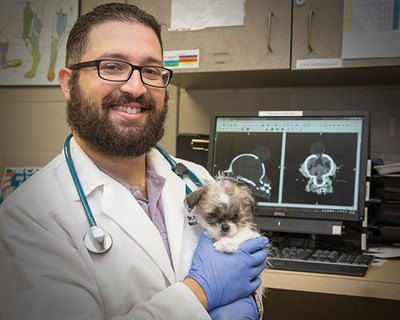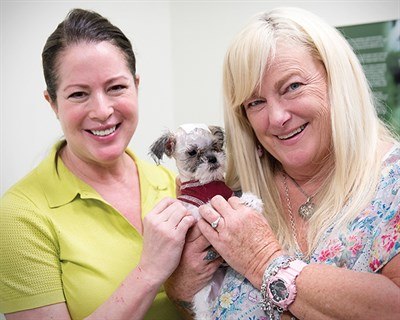But it wasn’t her sparkling disposition that led to the moniker; Bubbles received her name because she was born with meningoencephalocele—a rare, abnormal sac of fluid, brain tissue, and meninges (the membranes that cover the brain and spinal cord) that protrudes from the top of her head.
When Darci Davenport, the co-owner of peacelovedogs/PLD Dog Rescue Project in Missouri City, learned from a friend that the 5-week-old puppy was dropped off at a Montgomery County animal shelter, Davenport, whose rescue is known for taking in high-risk animals, went to visit Bubbles and fell in love.
“She has so much spunk,” Davenport said. “She’s just a regular puppy; she has no idea there is anything wrong with her. Once she bit my nose, it was over with.”
Davenport had Bubbles examined by a veterinarian in Houston, and the puppy was referred to the Texas A&M Veterinary Medical Teaching Hospital (VMTH), in the College of Veterinary Medicine & Biomedical Sciences (CVM), where she was cared for by a team from the Small Animal Hospital’s neurology service, including Dr. Beth Boudreau, third-year neurology resident Dr. Arturo Otamendi, and first-year neurology resident Dr. Maya Krasnow.
“Meningoencephalocele can happen either because of congenital abnormalities—the skull just didn’t form properly—or sometimes toxins or nutritional deficiencies can cause that in utero, as well; sometimes it can be acquired because of trauma,” Otamendi said. “In Bubbles’s case, it was congenital; she’s had it since she was born. This happens actually very rarely in dogs and cats, more commonly in people.”
The abnormality can cause seizures, and, if at any point the “bubble” ruptured, the puppy could suffer from meningitis, encephalitis, bleeding, and even death.
“We were worried about the pouch covering the outside potentially getting injured, because she’s a puppy and she’s pretty active,” Krasnow said. “She wants to be able to play with other dogs, but if the bubble were to become damaged, we would worry about her potentially getting encephalitis. Additionally, there is an opening in her skull—there’s nothing really there covering her brain—so we were worried about her experiencing trauma to her brain, as well.”
Otamendi, Krasnow, and other Texas A&M surgeons explored their treatment options and decided surgery was the best approach. As they waited for the 2- to 3-pound puppy to get a little bigger in order to perform the surgery, they explored various surgical treatments, including working with a pharmaceutical/bioengineering company to produce a bio-compatible implant that could be placed over the defect in her skull.
A couple of weeks later, the doctors were presented a second option—one that involved technology being used by a surgeon in another of the hospital’s services; Dr. Brian Saunders, an associate professor of orthopedics, works in his laboratory with a memory foam implant that will become malleable at warmer temperatures and then hardens as it cools.
“We called him and asked if he knew anyone who did 3-D printing, which was our initial idea, and he volunteered that he and a chemist he works with might have something that could interest us,” Boudreau said.
With a surgical plan now in place, the doctors were ready to remove the meningoencephalocele from the top of Bubbles’s skull and implant the centimeter-and-a-half circle made from Saunders’s memory foam technology that would protect her brain. The two-and-a-half-hour surgery went off without a hitch.
“I think the biggest challenge was that we didn’t know quite what to expect during surgery; it’s not something that many of us have done before, and we weren’t sure what kind of complications we would run into,” Krasnow said. “But everything went extremely well. Our memory foam from Dr. Saunders’s lab actually fit in very well, and we didn’t have any problems. She woke right away after surgery and was eating, so we were really happy.”
The doctors emphasized the huge team effort that went into the surgery, including veterinary specialists from the Small Animal Hospital’s neurology, orthopedic, surgery, anesthesia, and radiology services, as well as through the hospital’s fundraising mechanisms, which helped offset the cost of Bubbles’s surgery.
“We were able to combine funds for the surgery through the Laughing Labs, Robbie Vanderpool Save the Animals, and Starr Funds accounts,” Otamendi said. “We definitely thank everybody at Texas A&M and the Texas A&M Foundation for helping to provide these funds so we could perform the surgery that will allow Bubbles to hopefully live a better life.”
Through her rescue project, Davenport had raised some money before Hurricane Harvey hit the Houston area, but afterward, because there were so many others in need, Davenport said she felt guilty about asking for more for one dog when so many other people and animals were in need.
“She’s just so cute; she’s so sweet and has such a will to live that I want to do whatever I can to get her better,” Davenport said. “She has such a spunk and so much will to live that how do you deny that a puppyhood?”
Davenport said it means a lot to her that Texas A&M worked to help financially.
“To me, this is the most amazing university ever; it’s the best of the best. We don’t hesitate, any time we have something that’s complicated, to just drop everything and drive the two-and-a-half hours to Texas A&M, because you’re not going to get any better care,” Davenport said. “They are so caring, and for them to help the way they have and go out of their way to accommodate Bubbles and my rescue is…I’m just so grateful.”
Throughout this process, Davenport worked to find a good home for Bubbles to return to after her surgery. She found that in Houston resident Theresa Cline, who learned about Bubbles through a friend.
“I lost my dog to breast cancer three months before I saw Bubbles, and I was just so distraught; I didn’t know if I was going to have another dog anytime soon,” Cline said. “When I saw Bubbles, it was about at that three-month mark (following her dog’s death) and Bubbles was almost 3 months old; as soon as I saw her, I was like, ‘That’s my dog!’ I just kind of felt like my dog’s soul was in this dog; she just kept pulling me in. I knew I was done, that this was my dog.”
While Bubbles no longer has the meningoencephalocele that earned her her name, she does have a sister with whom she can play now that she’s fully recovered and officially a “normal” puppy. As she waited for Bubbles, Cline adopted Mai—a puppy she said looks so similar to Bubbles that they could have come from the same litter—so that Bubbles wouldn’t be alone.
For Davenport, knowing that she found a home for her little “Unicorn Puppy”—a puppy that, under normal circumstances, may not have survived to make it to a shelter, much less through surgery—is bitter sweet.
“Everybody said, ‘You’re not going to be able to let her go,’” Davenport said. “But this is what I like—to be able to send a dog home with someone like Theresa; that’s my job.”
###
For more information about the Texas A&M College of Veterinary Medicine & Biomedical Sciences, please visit our website at vetmed.tamu.edu or join us on Facebook, Instagram, and Twitter.
Media contact: Megan Palsa, Executive Director of Communications, College of Veterinary Medicine & Biomedical Sciences; mpalsa@cvm.tamu.edu; 979-862-4216
This story originally appeared in the Spring 2018 edition of CVM Today magazine.







